Accident Lawyer
Can You Ride a Bicycle on the Highway?
There is no federal law that directly answers the question: Can you ride a bicycle on the highway? The federal government leaves decisions about bicycle use on highways to state laws and local authorities. That means the legality of highway cycling can vary not only from state to state, but even between different areas of the same city.
This guide explains the rules and restrictions in different areas and how local regulations and traffic control devices affect your right to ride. It also looks at how violating these rules may affect your ability to claim compensation if you’re injured in a bike accident. Understanding your rights could make a significant difference after a bicycle accident on or near a highway.
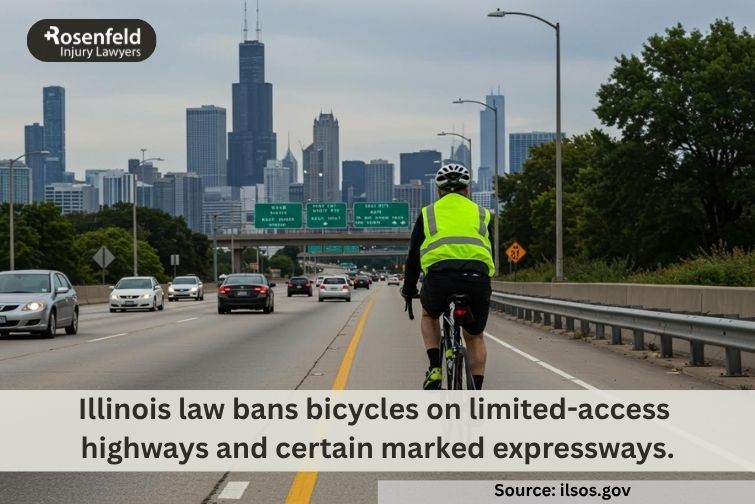
What Is a Highway?
A highway is any public road that’s open to motor vehicles and other road users, typically built for long-distance travel and higher speed limits. Highways often connect major cities, suburbs, and rural areas. Some have lanes or shoulders that may be used for cycling, depending on local laws and traffic control devices.
In legal terms, a highway can refer to any main road maintained by a public authority, whether it’s a controlled-access highway or a smaller bicycle route.
What Is the Difference Between a Highway and a Freeway?
While all freeways are highways, not all highways are freeways. A freeway is a type of limited-access highway designed for fast-moving traffic with no cross traffic, intersections, or traffic lights. Access is restricted to on- and off-ramps, which makes it unsafe and often illegal for non-motorized vehicles, including bike riders, to enter.
Freeways usually carry high-speed traffic across long distances and are often part of the interstate freeway system. In many states, bicyclists are not allowed on specific urban freeways due to safety concerns and normal speed differences between bicycles and motorized vehicles.
What Is the Difference Between a Highway and an Interstate?
An interstate is a federally funded, multi-state highway that’s part of the National Highway System. Known as interstates, these roads cross state lines and are built to strict federal standards for speed, safety, and access.
Such a roadway is limited-access, with multiple lanes of motor vehicle traffic moving in the same direction and no allowance for bike use. Many states and cities prohibit bicyclists from using interstates, except where no alternative route judged equal is available. Even then, local traffic regulations and state laws determine what’s allowed.
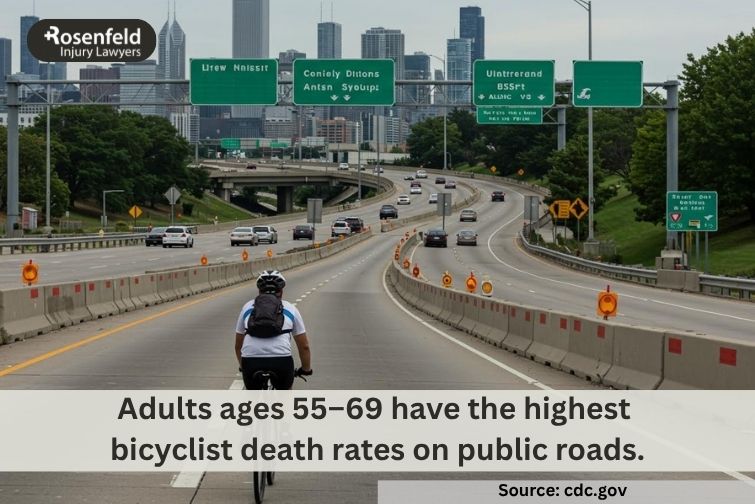
What Is the Federal Law on Highway Cycling?
Federal law doesn’t provide a clear answer to whether you can ride a bicycle on the highway. Instead, each state—and often individual local authorities—set their own rules. That means the legality of cycling on such a roadway can change not only across state lines, but even between neighborhoods in the same city.
While the federal laws do provide funding and guidelines for interstates and specific urban freeways, they don’t set rules about non-motorized traffic like bicycles. Instead, each state decides whether to allow bike riders on controlled- or limited-access highways, as well as multi-lane roads with high-speed vehicles.
How Do State Laws Regulate Bike Riding on Highways?
Alabama
In Alabama, cyclists are not allowed on interstate or expressways. Riders must stick to local streets, lanes, or dedicated bike routes.
Alaska
Alaska allows bicycle use on many highways, including some interstates outside of city areas. However, if traffic control devices prohibit bikes, the law must be followed. In some remote areas, where there’s no alternative route judged equal, cycling on highways is legal.
Arizona
Arizona permits cycling on highways unless traffic control devices or signs prohibit it. In rural areas, some interstates may allow bicycles if no suitable alternative exists. Cyclists must obey traffic lights, ride with the traffic, and follow all applicable local traffic laws for safety.
Arkansas
Arkansas bans bicycles from controlled-access and interstate highways, regardless of traffic conditions. Cyclists must use local roads, shoulders, or bike lanes, where available. Local governments may enforce stricter rules, and violating these regulations can impact a rider’s ability to seek compensation following a bike accident.

California
California prohibits cycling on interstates and freeways when traffic control devices are posted. However, exceptions exist in rural areas where the local government allows it and where no suitable alternative is available.
Colorado
Colorado permits bicycles on some interstates in rural areas. In cities, local ordinances may restrict access to certain urban freeways to protect bicyclists from high-speed vehicles.
Connecticut
Bicycles are banned from interstates and expressways in Connecticut. These roads are reserved for vehicles traveling at high speed, and non-motorized traffic is not allowed.
Delaware
Delaware bans cycling on highways with controlled access, especially interstates. Riders should stick to city streets or marked bike routes. Failing to comply could impact liability and compensation in a bicycle accident case.
Florida
Florida prohibits cycling on expressways, including interstates, unless specifically allowed. Bicycles are considered vehicles, so riders must obey all traffic regulations, use designated lanes where present, and yield to vehicles when required.
Georgia
Georgia law prohibits bicycles on controlled-access and interstate highways throughout the state. Riders must follow local rules and use local roads or designated lanes.
Hawaii
Hawaii bans cycling on all controlled-access and interstate highways. Cyclists must use neighborhood streets or marked routes. Riding in restricted areas can impact your legal rights if you’re involved in a bicycle accident.
Idaho
Idaho allows riding a bicycle on highways, including some interstates, unless traffic control devices prohibit it. In rural areas with no alternative route, bicycles are often permitted. Riders must follow traffic regulations and stay far right to avoid interfering with vehicle traffic.
Illinois
Illinois prohibits cycling on controlled-access and interstate highways unless a suitable alternative does not exist and the local government allows it. Cyclists must follow all traffic regulations, stay right, and use designated lanes or local roads when available to avoid potential legal issues and accidents.
Indiana
Indiana law bans bicycles on interstate and other expressways. Cyclists are expected to follow all traffic regulations.
Iowa
Iowa permits bike riding on most highways, including some interstates in rural areas, unless signs prohibit it. Cyclists must ride right, obey traffic lights, and yield to motorized vehicles. City local ordinances may ban bicycles on certain highways with controlled access to increase cyclist safety.
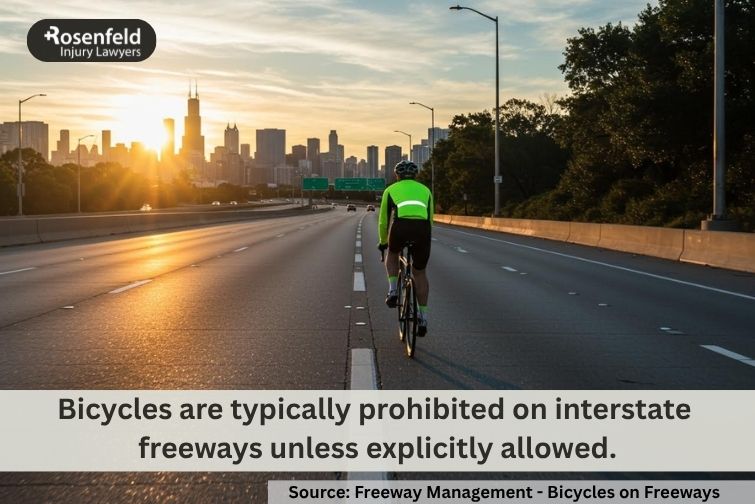
Kansas
Kansas allows bicycles on highways unless traffic control devices prohibit access. Some interstates permit cyclists in rural areas, especially if there’s no suitable alternative route.
Kentucky
Kentucky prohibits bicycles on controlled-access and interstate highways statewide. Cyclists must use designated routes or municipal roads. Violating these rules can impact your ability to claim compensation after an accident, especially if you’re found to have broken traffic regulations.
Louisiana
Louisiana law prohibits bicycles on controlled-access and interstate highways unless the local government approves. Cyclists must follow traffic regulations, use urban roads or designated lanes, and obey all signs. Riding where banned could affect a cyclist’s legal standing in a bicycle accident case.
Maine
Maine prohibits bicycles on interstates, but allows them on other highways unless signs say otherwise. Cyclists must ride with traffic, stay far right, and follow traffic regulations. Ordinances may restrict access on roads with high-speed vehicles or multiple vehicle lanes.
Maryland
Maryland bans cycling on interstate and controlled access highways. Cyclists must use surface streets or designated routes. Cyclists are subject to traffic regulations and must yield to motorized vehicles at intersections, including during a left turn or while riding near cross traffic.
Massachusetts
Massachusetts prohibits bicycles on interstates and expressways. Cyclists must follow all traffic regulations and avoid roads with high-speed vehicles. Traffic control devices and ordinances may further restrict bicycle use, especially in areas with heavy vehicle traffic.
Michigan
Michigan bans bicycles on expressways, including interstates, unless otherwise posted. Cyclists must use designated lanes and follow local traffic regulations. Riding where prohibited can impact your legal rights in the event of an accident.
Minnesota
Minnesota allows cycling on some interstates in rural areas unless signs prohibit it. In urban areas, local ordinances may ban access. Riders must obey traffic regulations, use shoulders when needed, and avoid highways where non-motorized vehicles are considered unsafe due to high-speed traffic.
Mississippi
Mississippi bans bicycles from interstate and expressways. Cyclists must follow traffic regulations, use alternative routes, and stay to the right side of the road. Riding where prohibited may reduce a cyclist’s right to compensation.
Missouri
Missouri prohibits cycling on interstates, but permits bicycles on other highways unless signs indicate otherwise. Cyclists must obey traffic rules and stay off expressways in urban areas to reduce the risk of accidents.
Montana
Montana allows bicycles on many interstates, particularly in rural areas without a suitable alternative. Cyclists must follow traffic regulations, ride on shoulders, and obey all traffic control signs and devices to avoid the risk of accidents, especially when sharing roads with high-speed vehicles.

Nebraska
In Nebraska, cycling on interstates is generally forbidden, but it is permitted on other highways unless posted otherwise. Cyclists must ride with the traffic and follow all traffic regulations. Local signage may prohibit bicycles on multi-lane roads with heavy vehicle use.
Nevada
Nevada permits bicycles on some interstates, mainly in rural areas with no comparable route available. In major cities, access is often restricted, and cyclists must stay right and follow all traffic regulations to avoid collisions with motorized vehicles.
New Hampshire
New Hampshire bans bike riding on interstates and most expressways. Cyclists must follow local traffic regulations and ride on local roads.
New Jersey
New Jersey prohibits bicycles on most interstates and specific freeways. Bike riders must follow ordinances, use residential roads or bicycle routes, and obey traffic regulations. Cyclists riding in restricted zones may be cited and could jeopardize their rights in accident claims.
North Dakota
North Dakota allows cycling on many interstates, especially in rural areas where no suitable alternative route exists. Cyclists must follow traffic regulations, ride on shoulders, and obey any traffic control signs. Local traffic regulations may limit access in cities or urban zones.
Ohio
Ohio prohibits bicycles on controlled-access and interstate highways. Cyclists must use bicycle lanes or alternate routes and obey all traffic regulations. Disregarding these restrictions may reduce a cyclist’s ability to recover compensation after an accident.
Oklahoma
Oklahoma permits bicycles on highways unless traffic control devices prohibit access. Some interstates in rural areas allow cyclists, particularly where no suitable alternative exists. Cyclists must obey traffic signs, ride with traffic, and stay far right to reduce the risk of accidents.
Oregon
Oregon allows bicycles on many interstates, especially in rural areas. Cyclists must follow traffic regulations and use shoulders. In cities, access to specific freeways may be restricted to protect cyclists from high-speed vehicles and multi-vehicle lanes.
Pennsylvania
Pennsylvania prohibits cycling on interstates and most expressways. Cyclists must follow local ordinances, use designated routes, and obey traffic regulations.
Rhode Island
Rhode Island prohibits bicycles on controlled-access and interstate highways. Cyclists must use local roads, follow signs, and ride with the traffic. Ignoring restrictions can affect liability for an accident and limit a cyclist’s right to compensation after being struck by a vehicle.
South Carolina
South Carolina bans cycling on interstates and other expressways. Cyclists must follow traffic regulations, use bike routes, and ride with the traffic.
South Dakota
South Dakota allows bicycles on many interstates, especially in rural areas. Bike riders must follow traffic regulations, stay on shoulders when available, and obey traffic control signs. The local government may restrict access in cities, particularly on roads with high-speed vehicles.
Tennessee
Tennessee prohibits cycling on controlled-access and interstate highways unless the local government provides exceptions. Cyclists must obey all traffic regulations and avoid restricted roads.
Texas
In Texas, the Texas Transportation Commission may prohibit bicycles on interstate or expressways if an alternative exists. Bike riders must follow traffic regulations and avoid high-speed areas unless permitted. Violations could affect liability in an accident claim.
Utah
Utah allows bicycles on most interstates, especially in rural areas where no alternative route exists. Bike riders must ride far right and obey all traffic signs. Some urban freeways may ban bikes through traffic control signs to protect bicyclists.
Vermont
Vermont prohibits bicycles on interstate and expressways. Cyclists must use local roads, follow traffic regulations, and ride with traffic. Entering restricted highways without permission may impact a rider’s legal standing after an accident.
Virginia
Virginia bans bicycles on interstates and most highways with controlled access unless signage permits. Bike riders must obey all traffic regulations, ride single file, and avoid high-speed areas.
Washington
Washington permits bicycles on most interstates outside urban zones unless traffic control devices restrict access. Cycling may be banned on specific freeways to protect riders from high-speed vehicles. Riders must obey traffic regulations.
West Virginia
West Virginia bans cycling on controlled-access and interstate highways. Cyclists must use designated lanes and follow traffic regulations. Violating posted rules may impact your ability to recover compensation after a bicycle accident involving other vehicles.
Wisconsin
Wisconsin prohibits bicycles on interstates but allows access to other highways unless signage states otherwise. Bike riders must follow traffic regulations, stay right, and ride single file when required. Unauthorized access can affect your rights in an accident.
Wyoming
Wyoming allows bicycles on many interstates, especially in rural areas lacking a suitable alternative. Riders must obey traffic regulations, use shoulders when possible, and stay visible. Violating traffic rules or riding unsafely near high-speed vehicles may reduce legal protection after a bicycle accident.
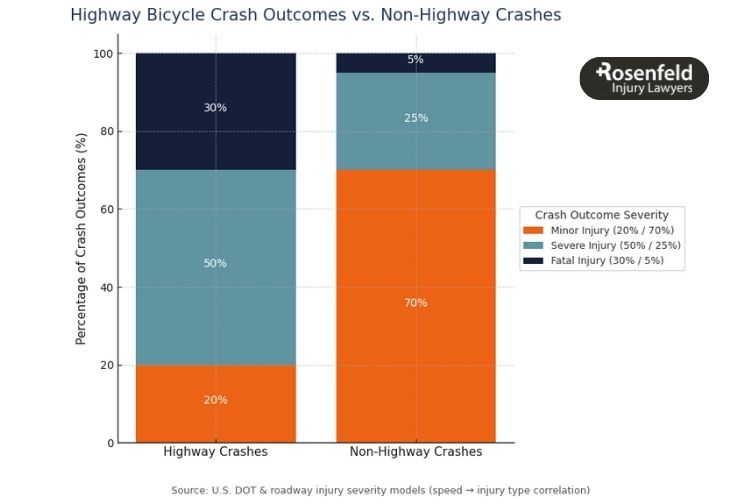
What Are the Challenges of Cycling on Highways?
High-Speed Traffic
Riders share the road with vehicles moving at highway speeds, which increases the risk of serious injury in the event of a collision or close pass.
Wind and Turbulence from Vehicles
Large trucks and fast-moving vehicles create strong gusts and suction effects that can destabilize a cyclist or pull them off course.
Debris and Poor Road Conditions
Highways often have gravel, tire fragments, metal grates, or uneven pavement, especially near the shoulder where bicycles typically travel.
Limited Access and Exits
Highways often lack safe or clearly marked entry and exit points for cyclists, making it difficult to join or leave the roadway safely.
Rapidly Changing Weather
Exposure to wind, rain, or sudden temperature changes can affect visibility, bike handling, and rider endurance during longer trips on open highways.
Physical Fatigue and Dehydration
Long distances and limited rest opportunities can lead to exhaustion, reduced focus, and slower reaction times–especially without access to water or food.
Complex Intersections and Ramps
Exit and merge areas involve fast-moving vehicles and changing traffic flow that can be difficult to navigate on a bicycle.
Group Coordination Challenges
When riding in groups, maintaining safe spacing, formation, and communication is harder on highways due to speed differences and limited space.
Mechanical Issues or Emergencies
Flat tires, gear problems, or collisions may occur far from help. Shoulders may be narrow, and there’s often no safe space to stop or seek assistance.

How Do Traffic Laws in Illinois View Cycling on Highways?
Under the Illinois Vehicle Code (625 ILCS 5/), cyclists are considered vehicle operators under the law and must follow the same rules that apply to drivers of motor vehicles. Under 625 ILCS 5/11-711, the Illinois Department of Transportation (IDOT) has the authority to prohibit bicyclists and other slow-moving or vulnerable road users from using controlled-access highways.
Once traffic control devices or signs are posted, the restrictions are legally enforceable, and cyclists are not allowed to enter those roadways. Violating these rules can result in citations or removal by a police officer. The law ensures that only vehicles capable of maintaining the expected speed for that roadway use these highways, reducing hazards for all road users.
Kane County
Aurora follows state bicycle laws but emphasizes bike lane and route signage throughout the city. While not all major roadways are restricted, cycling is discouraged in areas with multiple lanes and heavy traffic, especially near I-88 and I-55 access points. Ordinances restrict non-motorized vehicles from certain high-speed roads where alternatives are available.
Elgin generally adheres to state law, but local traffic laws reinforce that cyclists may not use controlled-access highways or bridges designed for motor vehicle use only. Some city-maintained streets parallel to highways have designated lanes
DuPage County
In areas of Aurora falling within DuPage, bicycles are not permitted on controlled-access or interstate highways unless marked otherwise.
Naperville’s municipal code echoes state law and encourages the use of bike routes. The city has added signage near interstates discouraging cycling. Naperville actively promotes safety tips and provides maps showing alternative paths for long-distance cycling.
Wheaton prohibits bicycles from expressways under local ordinance, matching statewide rules. Bicycles must remain on city streets or designated trails. The city provides guides for bicycle riders and sets out additional equipment expectations, especially for riding during low-visibility hours.
Bolingbrook restricts non-motorized vehicles from roadways with posted speed limits over 45 mph unless a bike route is marked. Ordinances require additional rear lighting after dusk beyond state minimums. Riding a bicycle is uncommon here due to wide arterials and few alternative routes.
Will County
In the Will portion of Aurora, ordinances from the city apply in full, including general compliance with traffic laws.
Naperville’s ordinances are enforced consistently across both counties.
Joliet bans bike riders from interstates and other expressways within city limits. City code emphasizes yielding to other vehicles at intersections and using sidewalks only where permitted. Joliet promotes trail access as an alternative for long-distance travel.
Bolingbrook ordinances also apply in the Will County portion of the village. The town has no exemptions allowing bicycle access to controlled access roads.
Kendall County
In areas of Aurora falling within Kendall, the city’s existing ordinances continue to apply.
Winnebago County
Rockford’s traffic ordinances align with state law. Bicycles are not allowed on controlled access highways, and signage prohibits bicycles on certain overpasses and lanes leading to interstates. Rockford offers guidance for electric bicycle operation on shared-use paths.
Cook County
In Chicago, bicycles are prohibited on expressways and controlled-access highways. The city maintains an extensive network of bike lanes and designated routes to support cyclist safety. Riders must follow traffic control devices and are encouraged to use marked bike lanes instead of high-speed arterials.
Oak Park bans non-motorized vehicles on specific freeways and arterials feeding into I-290. The village promotes shared-road safety and enforces helmet use for riders under a certain age. The local police department may stop cyclists for riding on restricted highways or ignoring official traffic control devices.
Schaumburg has an extensive bike lane and trail network and limits cycling on streets with high-speed vehicles. Ordinances restrict bicycles from sections of Meacham Road and Higgins Road near highway interchanges. Signage guides riders to alternative routes.
Skokie prohibits bicycles on certain controlled access roadways and has adopted additional reflectivity rules for bicycles. The village maintains maps showing bike routes and city roadways safe for cycling.
Cicero prohibits cycling on certain major thoroughfares feeding into interstates. Local law requires front and rear lights on all bicycles at night, even within city limits. Some ordinances impose restrictions on group cycling, requiring permits for large rides.
Sangamon County
Springfield restricts non-motorized vehicles on all interstates and most expressways. Cyclists are allowed on local streets but are advised to avoid Veterans Parkway and similar high-speed arterials. Springfield PD may issue citations for violating state laws or local traffic regulations.
Peoria County
Peoria enforces state restrictions on controlled access highways and interstate freeways. The city has designated bike lanes on downtown streets and encourages cyclists to follow safety tips, such as using hand signals and maintaining visibility during heavy traffic periods. Local rules prohibit riding more than two abreast on shared roadways.
Lake County
Waukegan restricts cycling on roadways with speed limits over 50 mph unless part of a designated route. Signage is used to direct cyclists away from highway on-ramps and direct access to limited-access roads. Local regulations support educational programs for bike riders.
Champaign County
Champaign enforces state prohibitions on interstate highways and limits cycling on state roads where alternative routes are deemed safer. The city supports shared-road education and maintains bike lanes on most arterials. Cyclists must follow all traffic regulations and yield to other vehicles where applicable.
Highway Cycling Safety Tips
Stay visible at all times.
Wear standout colors: Bright or fluorescent clothing helps drivers spot you sooner.
Use bike-mounted lighting: Steady or flashing lights make you more noticeable in traffic.
Add reflective elements: Tape, decals, or gear reflect headlights from multiple angles.
Ride in a consistent, predictable manner.
Hold your line: Avoid weaving in and out of the shoulder or lane.
Use hand signals clearly: Indicate turns and lane changes in advance.
Avoid abrupt maneuvers: Sudden swerves or stops can lead to collisions.
Be fully alert to your environment.
Watch the pavement: Scan ahead for broken surfaces, debris, or road seams.
Listen for approaching traffic: Sound can warn you before sight does.
Stay distraction-free: Avoid earbuds, screens, or anything that dulls awareness.
Plan for the road ahead.
Verify bike access: Not all highways allow bicycles, even in rural areas.
Identify safe entry and exit points: Some stretches lack clear access for non-motorized vehicles.
Review weather and traffic updates: Conditions can change quickly and affect safety.
Be ready for the unexpected.
Carry a patch kit or spare tube: A flat tire miles from help can be dangerous.
Pack enough water and snacks: Highway stretches may not have nearby services.
Bring ID, cash, and a phone: These basics help in emergencies or detours.
Stay steady in wind and turbulence.
Brace for truck drafts: Large vehicles can create a sudden pull or push.
Keep a safe buffer: Stay off the edge and allow room to correct your line.
Use mirrors to reduce blind spots.
Install a helmet or handlebar mirror: Allows you to track traffic behind you without turning your head.
Interact clearly with drivers.
Make eye contact at merge points: Confirms you’ve been seen.
Acknowledge safe drivers: A wave or nod encourages respectful road sharing.
Keep up with local cycling rules.
Review local and state rules: Access varies based on jurisdiction and road type.
Watch for signage: Some areas may restrict bike use without advance notice.
Follow group riding guidelines.
Stay single file where required: Keeps traffic moving and aligns with many local regulations.
Call out hazards and changes: Hand signals or quick shouts help avoid accidents.
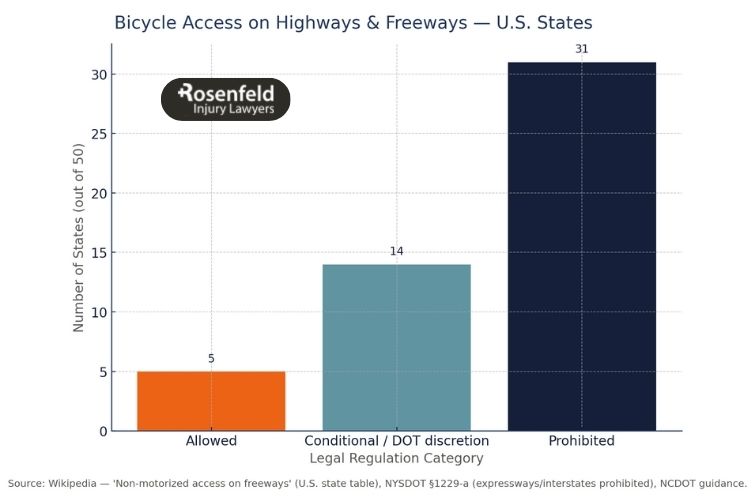
What to Do If You Get in a Bicycle Accident on the Highway
Move to safety if possible.
If you’re able, get out of the traffic lane and onto the shoulder or a protected area. Avoid standing in blind spots or near fast-moving traffic.
Call 911 right away.
Request police presence, especially if a motor vehicle was involved. The responding officer will file a report, which may be essential for any legal claim.
Get medical attention.
Even if injuries seem minor, accept treatment at the scene or go to the ER afterward. Some injuries – including concussions and internal trauma – may not show up immediately.
Exchange information.
If a driver or another party was involved, collect their name, contact info, driver’s license number, and insurance details. Avoid arguing or admitting fault at the scene.
Document the crash.
Take photos of your bike, the vehicle, road conditions, official traffic control devices, injuries, skid marks, or debris. Make note of the exact location, weather, and time.
Look for witnesses.
If anyone stopped or saw the incident, ask for their name and contact info. Neutral third-party accounts can support your version of events.
Do not repair your bicycle.
Keep the bike in its post-crash condition. It may serve as evidence if there’s a dispute over speed, impact, or fault.
Report the accident to your insurance.
Depending on the situation, different insurance policies might apply. Stick to the facts when giving a statement.
Consult an attorney.
Talk with a lawyer before making claims. An attorney can explain your options and help pursue compensation.
Book a Free Consultation
If you or someone you love was injured while cycling on a highway, you don’t have to handle it alone. We offer a free consultation to help you understand your rights, what compensation may be available, and whether any restrictions on highway cycling could affect your claim. Contact us today to speak with a lawyer who understands how to protect the rights of bike riders.
Content reviewed by Chicago bicycle accident lawyer Jonathan Rosenfeld of Rosenfeld Injury Lawyers LLC, who holds negligent drivers, municipalities, and corporate defendants accountable to protect injured cyclists and their families, and is a trial lawyer recognized by National Trial Lawyers, Best Attorneys of America, and the National Association of Personal Injury Attorneys for high-severity injury claims.








